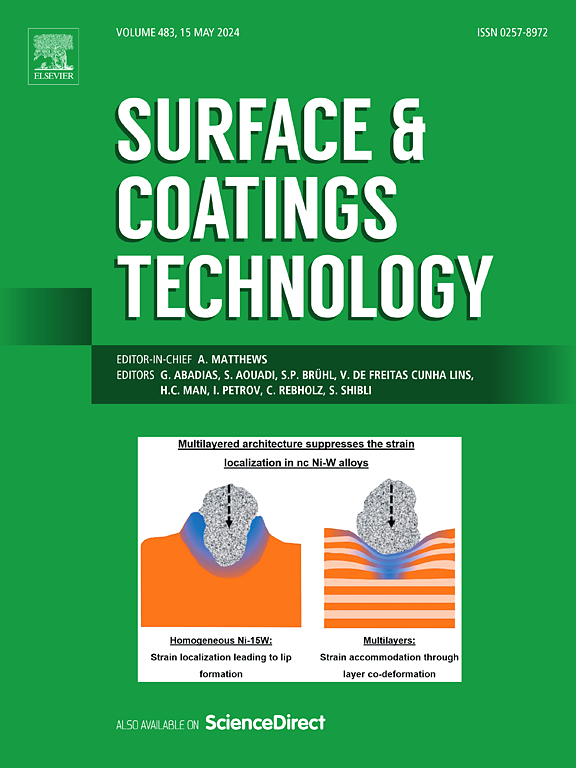Laser texturing of AA2024 alloy: A simplified approach to improve corrosion resistance and achieve superhydrophobicity
IF 5.3
2区 材料科学
Q1 MATERIALS SCIENCE, COATINGS & FILMS
引用次数: 0
Abstract
Despite its susceptibility to corrosion, AA2024 alloy is extensively used in the aerospace industry due to its favourable mechanical properties. Conventional corrosion protection methods frequently rely on hazardous chemicals and complex multi-step processes, which limits their sustainability and scalability. This study focuses on the development of an environmentally friendly, simplified laser-based method that structures surfaces in a single scan, producing line-like microstructures that achieve superhydrophobicity. The surfaces present static water contact angles of up to 160° and roll-off angles below 5°. The laser treatment results in the creation of a thicker Al2O3 oxide layer on the surfaces, as evidenced by FIB-STEM images and the chemical characterization through XPS analysis. Consequently, the treated surfaces exhibit a notable enhancement in polarization resistance, rising from 23.6 kΩ cm2 to 159.5 kΩ cm2. This study provides insights into the viability of a novel, simple, laser-based approach for corrosion protection that exhibits additional wetting properties.

AA2024合金的激光织构:一种提高耐蚀性和实现超疏水性的简化方法
尽管AA2024合金易腐蚀,但由于其良好的机械性能,它在航空航天工业中得到了广泛的应用。传统的防腐方法经常依赖于危险化学品和复杂的多步骤过程,这限制了它们的可持续性和可扩展性。本研究的重点是开发一种环保、简化的基于激光的方法,该方法在一次扫描中构建表面,产生实现超疏水性的线状微结构。表面的静态水接触角可达160°,滚转角低于5°。通过FIB-STEM图像和XPS分析的化学表征可以证明,激光处理导致表面产生更厚的Al2O3氧化层。因此,处理后的表面极化电阻显著增强,从23.6 kΩ cm2增加到159.5 kΩ cm2。这项研究为一种新颖、简单、基于激光的防腐蚀方法的可行性提供了见解,该方法具有额外的润湿特性。
本文章由计算机程序翻译,如有差异,请以英文原文为准。
求助全文
约1分钟内获得全文
求助全文
来源期刊

Surface & Coatings Technology
工程技术-材料科学:膜
CiteScore
10.00
自引率
11.10%
发文量
921
审稿时长
19 days
期刊介绍:
Surface and Coatings Technology is an international archival journal publishing scientific papers on significant developments in surface and interface engineering to modify and improve the surface properties of materials for protection in demanding contact conditions or aggressive environments, or for enhanced functional performance. Contributions range from original scientific articles concerned with fundamental and applied aspects of research or direct applications of metallic, inorganic, organic and composite coatings, to invited reviews of current technology in specific areas. Papers submitted to this journal are expected to be in line with the following aspects in processes, and properties/performance:
A. Processes: Physical and chemical vapour deposition techniques, thermal and plasma spraying, surface modification by directed energy techniques such as ion, electron and laser beams, thermo-chemical treatment, wet chemical and electrochemical processes such as plating, sol-gel coating, anodization, plasma electrolytic oxidation, etc., but excluding painting.
B. Properties/performance: friction performance, wear resistance (e.g., abrasion, erosion, fretting, etc), corrosion and oxidation resistance, thermal protection, diffusion resistance, hydrophilicity/hydrophobicity, and properties relevant to smart materials behaviour and enhanced multifunctional performance for environmental, energy and medical applications, but excluding device aspects.
 求助内容:
求助内容: 应助结果提醒方式:
应助结果提醒方式:


